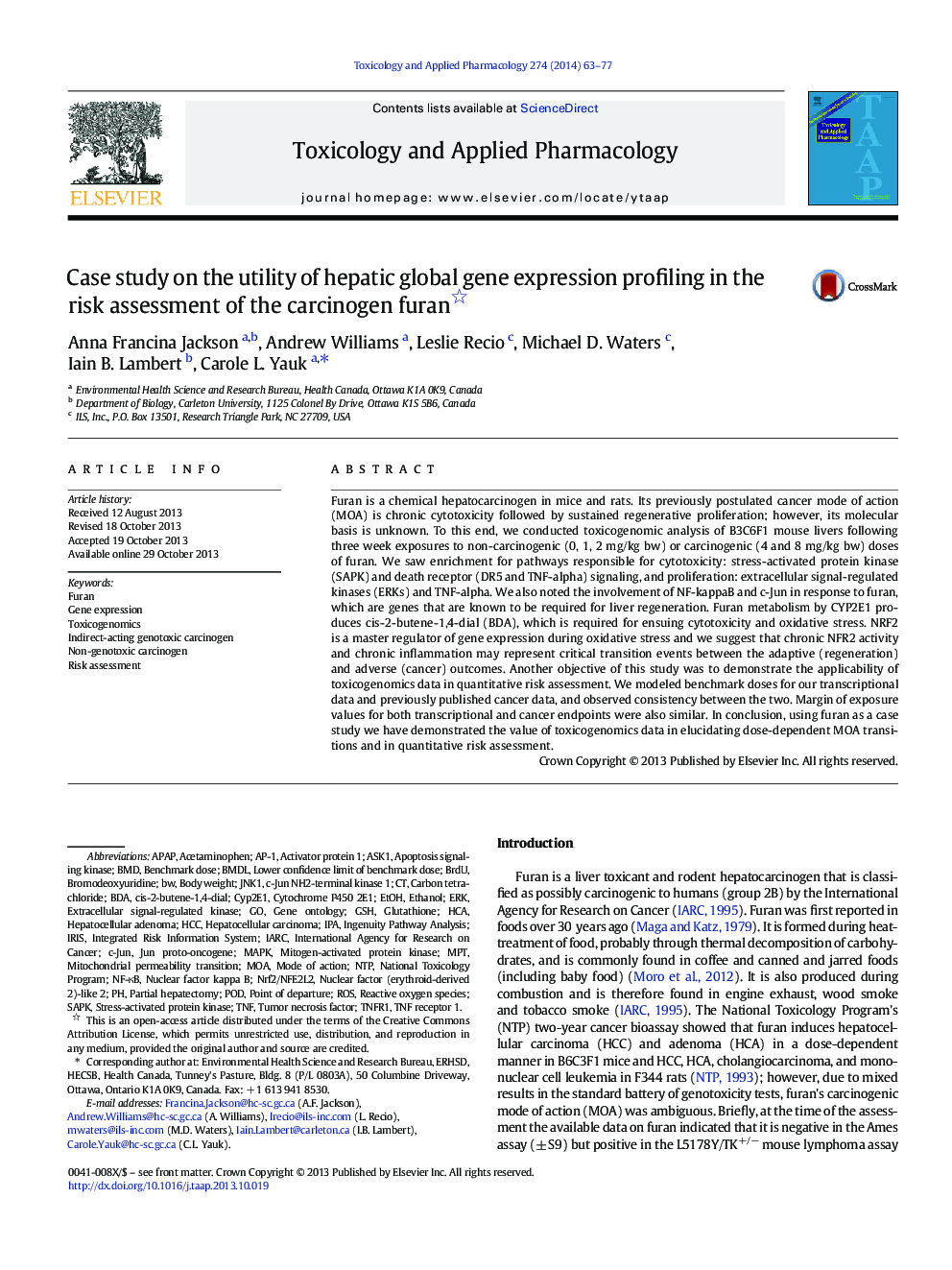| Article ID | Journal | Published Year | Pages | File Type |
|---|---|---|---|---|
| 5846283 | Toxicology and Applied Pharmacology | 2014 | 15 Pages |
Abstract
Furan is a chemical hepatocarcinogen in mice and rats. Its previously postulated cancer mode of action (MOA) is chronic cytotoxicity followed by sustained regenerative proliferation; however, its molecular basis is unknown. To this end, we conducted toxicogenomic analysis of B3C6F1 mouse livers following three week exposures to non-carcinogenic (0, 1, 2 mg/kg bw) or carcinogenic (4 and 8 mg/kg bw) doses of furan. We saw enrichment for pathways responsible for cytotoxicity: stress-activated protein kinase (SAPK) and death receptor (DR5 and TNF-alpha) signaling, and proliferation: extracellular signal-regulated kinases (ERKs) and TNF-alpha. We also noted the involvement of NF-kappaB and c-Jun in response to furan, which are genes that are known to be required for liver regeneration. Furan metabolism by CYP2E1 produces cis-2-butene-1,4-dial (BDA), which is required for ensuing cytotoxicity and oxidative stress. NRF2 is a master regulator of gene expression during oxidative stress and we suggest that chronic NFR2 activity and chronic inflammation may represent critical transition events between the adaptive (regeneration) and adverse (cancer) outcomes. Another objective of this study was to demonstrate the applicability of toxicogenomics data in quantitative risk assessment. We modeled benchmark doses for our transcriptional data and previously published cancer data, and observed consistency between the two. Margin of exposure values for both transcriptional and cancer endpoints were also similar. In conclusion, using furan as a case study we have demonstrated the value of toxicogenomics data in elucidating dose-dependent MOA transitions and in quantitative risk assessment.
Keywords
BMDCYP2E1MOAASK1Jnk1BDAIPAAPAPAP-1TNFR1MPTSAPKHCAERKGSHBMDLEtOHNTPTNFPODNF-κBHCCMAPKROSHepatocellular adenomaIARC یا International Agency for Research on CancerInternational Agency for Research on CancerEthanolRisk assessmentAcetaminophenmitochondrial permeability transitionNational Toxicology ProgramBrdUbromodeoxyuridineGene expressionIngenuity Pathway Analysisc-JunMode of actionbenchmark doseNon-genotoxic carcinogenToxicogenomicscytochrome P450 2E1Integrated Risk Information SystemIristumor necrosis factornuclear factor (erythroid-derived 2)-like 2nuclear factor kappa BFuranPoint of departureGene ontologyPartial hepatectomybody weightactivator protein 1mitogen-activated protein kinaseStress-activated protein kinaseJun proto-oncogeneHepatocellular carcinomaCarbon tetrachlorideextracellular signal-regulated kinaseGlutathioneReactive oxygen speciesTNF receptor 1
Related Topics
Life Sciences
Environmental Science
Health, Toxicology and Mutagenesis
Authors
Anna Francina Jackson, Andrew Williams, Leslie Recio, Michael D. Waters, Iain B. Lambert, Carole L. Yauk,
